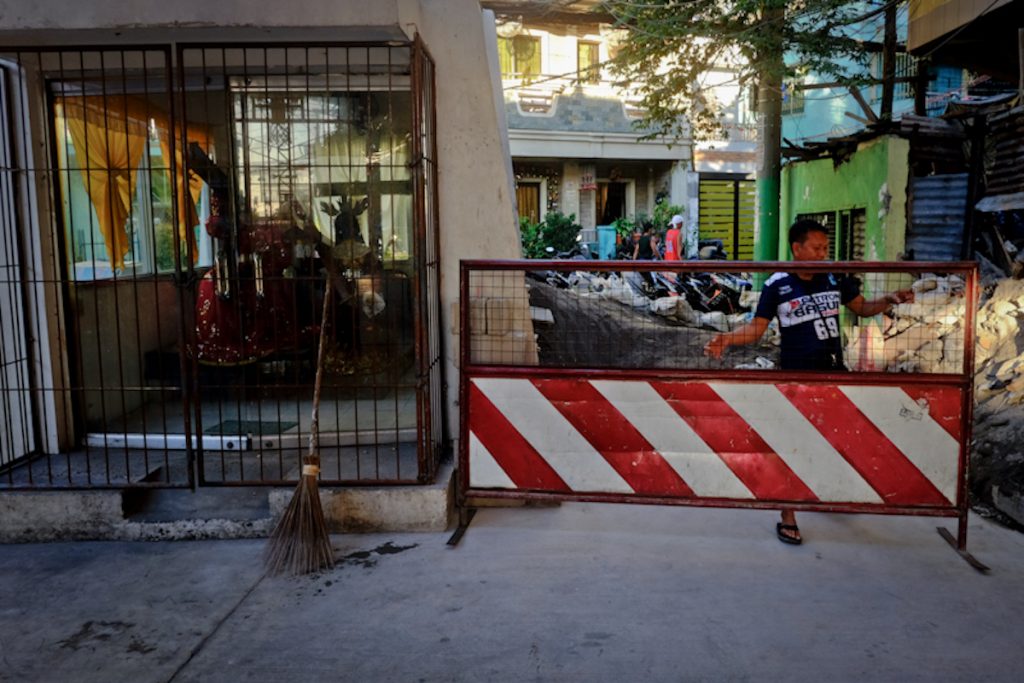“Look!” cried police Lt. Col. Reynaldo Magdaluyo, the truncheon-wielding commander of the Sta. Cruz police station in Manila and the so-called “action man” of road clearing operations in the city.
“Street, street, street,” he shouted as he swung his nightstick. He jabbed the air with his index finger as he pointed at the chapel and later tapped on its gate with his stick.
“In the middle of the street, they erected a chapel and turned it into storage for images of the Black Nazarene. This is just wrong!” shouted the colonel.
The chapel of the Black Nazarene stands smack at the center of the intersection between Varona and Francisco Streets in Manila’s Tondo district.
Inside are two life-size images of the charred Christ, a few small images of the Sto. Nino or Child-Jesus, and a large wooden cross resting against the windows.
“But it’s not even on a major road. These are secondary roads. And it’s practically a dead end. The chapel even creates a sort of rotunda,” said Manny Abuan, a Nazarene devotee.
The police officer said 14 years have passed and previous city officials have allowed the chapel to exist. It was just wrong, he said.
Abuan countered: “But as far as I can remember, the chapel has existed on this specific site, possibly since the sixties.”
“It’s a clear violation of the law,” said the policeman. “We cannot allow any government property to be used for religious activities. It’s in the Constitution,” he said.
“Move the Nazarene and demolish the chapel,” he commanded.


Like the homes of many informal settlers in the poor district of Tondo, tenure will not prevent the possible demolition of the Nazarene chapel.
Philippine President Rodrigo Duterte has given his marching orders to reclaim all public roads during his State of the Nation Address in July last year.
Incidentally, the president is a staunch critic of the Catholic Church.
In his various speeches, Duterte has repeatedly attacked the Church, calling it “the most hypocritical institution in the entire Philippines.”
The clergy are constant targets of his tirades, calling them sons of bitches, challenging them to fistfights, egging his supporters to beat them up, and even threatening to have them beheaded.
Following Duterte’s orders, the Interior Department issued a “memorandum circular” instructing all local government units to clear all roads, under their respective jurisdictions.
With Duterte’s directive and his anti-church sentiments, plus the marching orders of the Interior Department, it seems the small Nazarene chapel in Tondo is doomed to be demolished.
Abuan said the Nazarene chapel is an integral part of the cultural heritage of their village and the faith of the people in their community.
He claimed that devotees pass by the chapel to pray or just touch its walls to feel the presence of Jesus Christ in their everyday lives.
Abuan, who lives just a stone’s throw away from the chapel, has his own images of the Black Nazarene in his home.
Also, just a block away at another street corner, is another life-size image of the Black Nazarene, temporarily housed under a freestanding tent.
Abuan has personally appealed to the Manila mayor to save the Nazarene chapel from demolition.
It’s been over three months since Col. Magdaluyo’s road clearing operations in the village. The Nazarene chapel at the junction of Varona and Francisco Streets remains standing to this day.
It seems devotees from the village with a chapel in the middle of the street will celebrate this year’s “Feast of the Black Nazarene” with at least one answered prayer.


